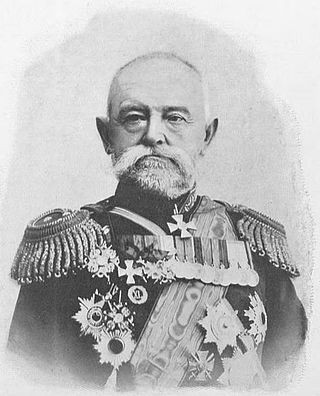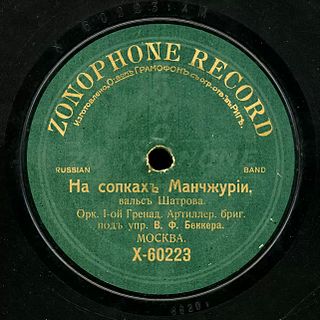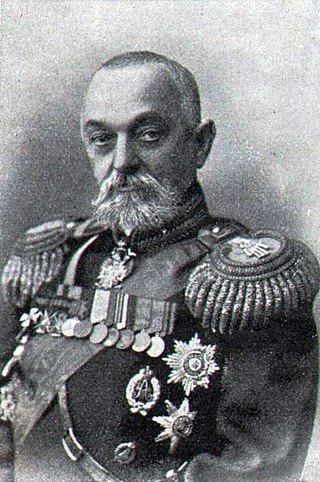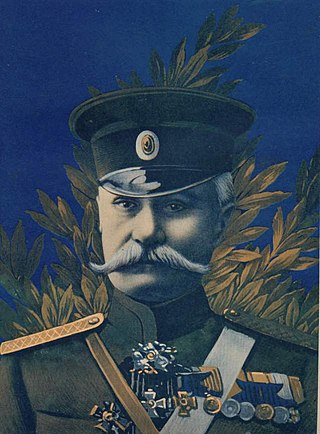
The Battle of Mukden, one of the largest land battles to be fought before World War I and the last and the most decisive major land battle of the Russo-Japanese War, was fought from 20 February to 10 March 1905 between Japan and Russia near Mukden in Manchuria. The city is now called Shenyang, the capital of Liaoning province in China.

Oskar Ferdinand Gripenberg was a Finnish-Swedish general of the Russian Second Manchurian Army during the Russo-Japanese War.

Nikolai Petrovich Linevich, also Lenevich and Linevitch was a career military officer, General of Infantry (1903) and Adjutant general in the Imperial Russian Army in the Far East during the latter part of the Russo-Japanese War.

The 10th Division was an infantry division in the Imperial Japanese Army. Its tsūshōgō code name was the Iron Division. The 10th Division was one of six new infantry divisions raised by the Imperial Japanese Army in the aftermath of the First Sino-Japanese War, 1 October 1898. Its troops were recruited primarily from communities in the three prefectures of Hyōgo, Okayama and Tottori, plus a portion of Shimane. It was originally headquartered in the city of Himeji, and its first commander was Lieutenant General Prince Fushimi Sadanaru.

The 8th Division was an infantry division in the Imperial Japanese Army. It was formed 1 October 1898 in Hirosaki, Aomori, as one of the six new reserve divisions created after the First Sino-Japanese War and was annihilated in the Philippines during the Pacific War at Rodriguez, Rizal in 1945. Its Tsūshōgō was Sugi. The 8th Division consisted of troops from the Tōhoku region of Japan, primarily Aomori, Akita and Yamagata Prefectures. Its first commander was General Tatsumi Naofumi, formerly commander of the Sendai Garrison.

The 9th Division was an infantry division in the Imperial Japanese Army. Its tsūshōgō code name was the Warrior Division or 1515 or 1573. The 9th Division was one of six infantry divisions newly raised by the Imperial Japanese Army after the First Sino-Japanese War (1894–1895). Its troops were recruited primarily from communities in the Hokuriku region of Japan (Ishikawa, Toyama and Fukui, with its headquarters located within the grounds of Kanazawa Castle.

Mikhail Ivanovich Zasulich was a general in the Imperial Russian Army, noted for his role as commander of the Russian 2nd Siberian Army Corps in the Battle of the Yalu River, of the Russo-Japanese War of 1904–1905.

Nikolay Aleksandrovich Kashtalinsky was a general in the Imperial Russian Army during the late 19th and early 20th centuries. He fought in the Russo-Turkish War (1877-1878), Russo-Japanese War of 1904–1905, and in World War I.

Baron Alexandr Alekseyevich Gerngross was a general of Dutch descent who served in the Imperial Russian Army during the late 19th and early 20th centuries.

"On the Hills of Manchuria" is a waltz composed in 1906 by Ilya Alekseevich Shatrov. The original and orchestral arrangement is written in E-flat minor while the folk arrangement is in F minor.

The Russian invasion of Manchuria occurred in the aftermath of the First Sino-Japanese War (1894–1895) when concerns regarding Qing China's defeat by the Empire of Japan, and Japan's brief occupation of Liaodong, caused the Russian Empire to speed up their long held designs for imperial expansion across Eurasia.

Nikolai Platonovich Zarubaev was an Imperial Russian general in the Imperial Russian Army in Manchuria during the Russo-Japanese War.

Mikhail Ivanovich Batyanov was a general in the Imperial Russian Army.
The 36th Rifle Division was a division of the Red Army and then the Soviet Army. The division was formed in 1919 as the 36th Rifle Division and fought in the Russian Civil War and the Sino-Soviet conflict of 1929. In 1937 it became the 36th Motorized Division. The division fought in the Battles of Khalkhin Gol. It was converted into a motor rifle division in 1940 and fought in the Soviet invasion of Manchuria in World War II. Postwar, it became a rifle division again before its disbandment in 1956. The division spent almost its entire service in the Soviet Far East.
The 1st Siberian Rifle His Majesty's Regiment was an infantry regiment of the Russian Imperial Army, part of the 1st Siberian Rifle Division. Existing from 1883 until 1918, it was part of the Russian force in Manchuria during the Boxer Rebellion, then later fought in the Russo-Japanese War at the battles of Liaoyang and Mukden, before taking part in World War I.
The 366th Rifle Division was an infantry division of the Red Army during World War II, formed twice.

The 2nd Manchurian Army was a field army of the Russian Empire that was established in 1904 during the Russo-Japanese War, to operate in Manchuria against Japan. It was one of the three such armies that were created and was disbanded in September 1905 after the end of the War.

The 3rd Manchurian Army was a field army of the Russian Empire that was established in 1904 during the Russo-Japanese War, to operate in Manchuria against Japan. It was one of the three such armies that were created and was disbanded in February 1906.

Konstantin Vikentyevich Tserpitsky was a Russian commander, lieutenant general, participant in the campaigns of 1873, 1875–1876, 1878 and 1880 in Turkestan, the Chinese campaign of 1900–1901 and the Russo-Japanese War of 1904–1905. He distinguished himself during the suppression of the Boxer Uprising (1900–1901). Brother of General Tserpitsky V.V., who died during the defense of Port Arthur.

Platon Alekseevich Lechitsky was a Russian general.
















